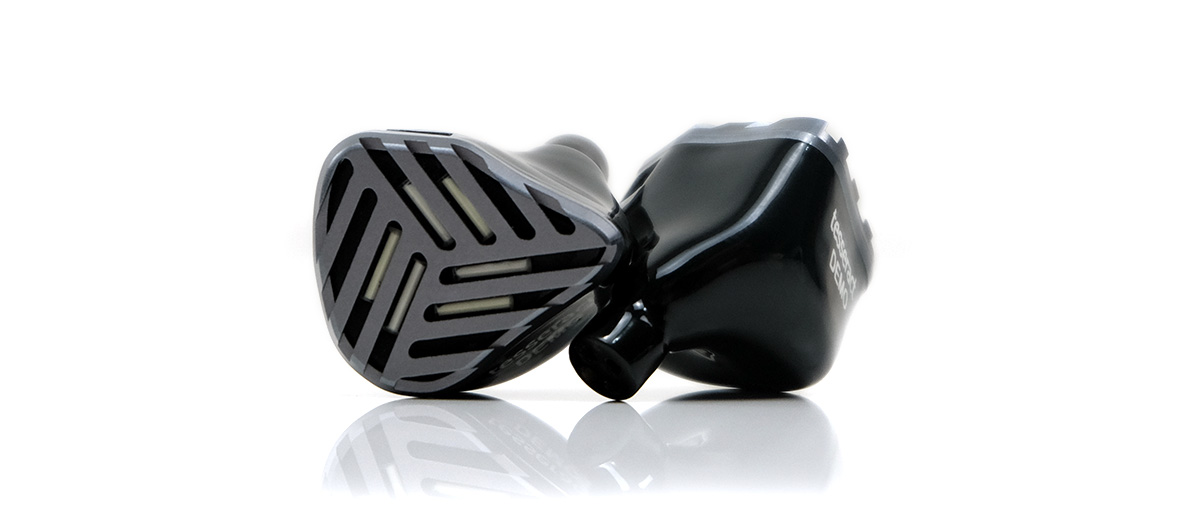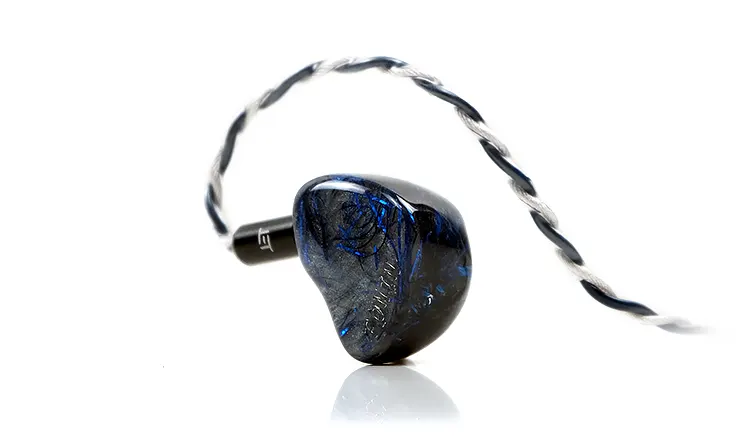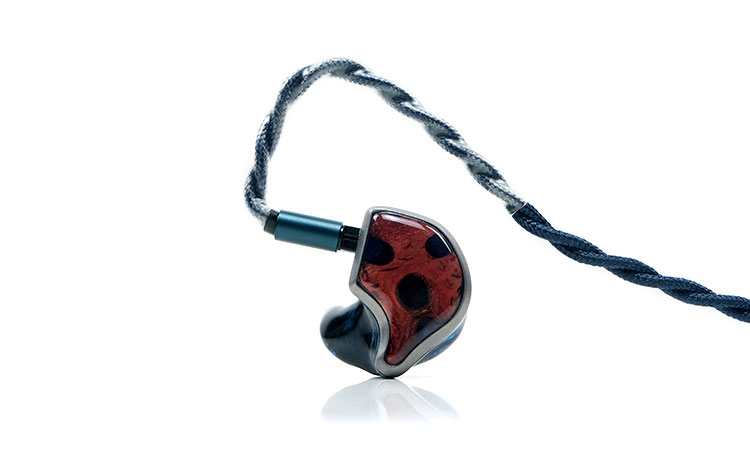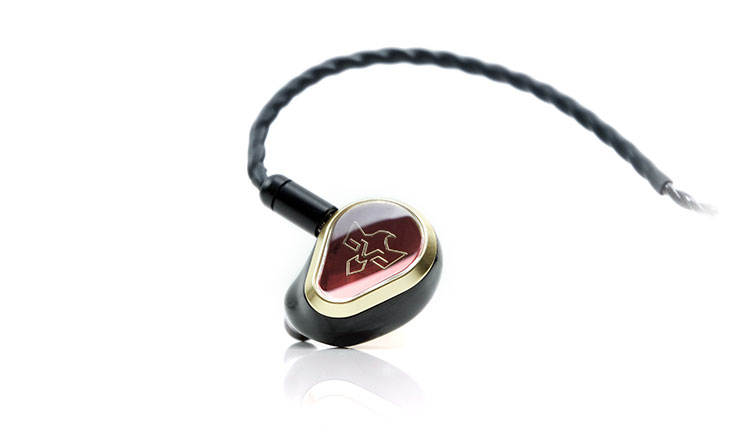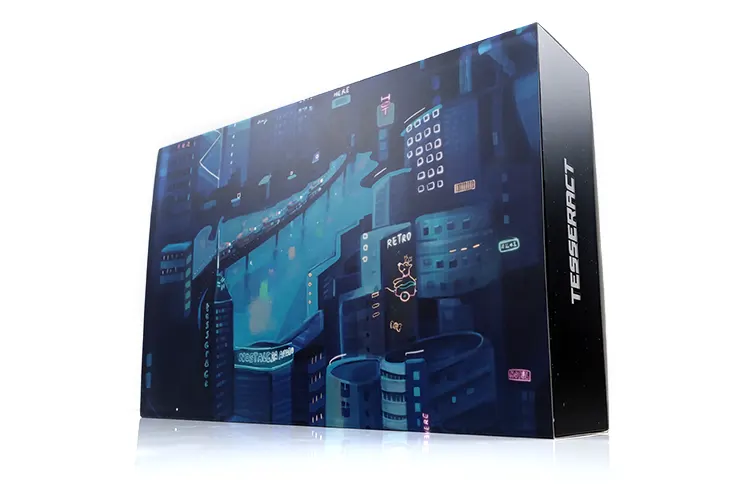Select Comparisons
The following comparisons to the Tesseract were completed using a mixture of the Cayin N7, the HiBy RS8, and the iBasso DX320 MAX Ti. All IEMs were fitted with their stock cables and stock tips except for the Mentor which is a custom IEM and does not require tips.
Noble Audio Ronin
The Noble Audio Ronin is the company’s latest co-flagship hybrid multi-driver universal in-ear monitor. You can read in more detail our thoughts on the Ronin here in our recent review.
Technical
The Ronin is perhaps the closest of our comparisons to the Tesseract in terms of driver mix with both using a selection of EST and BA drivers and no dynamic or bone conduction.
The Ronin uses 4 Sonion BA drivers for the sub-bass and bass, 4 Knowles full-range drivers for the lower mids and mids, and a quad driver EST array for the highs and super highs. The Tesseract uses 2 BA for the lows, 2 for the low mids, 4 for the mids, 2 for the highs, and no less than 6 EST for the ultra-high frequencies.
The Ronin is rated with an SPL of 114 dB SPL/mW and an impedance rating of 17Ω compared to the Tesseract’s 18Ω and a more efficient paper rating of 118 dB using the same SPL weighting of @ 1kHz, 1mW.
In our real-world testing, there is not a huge amount of difference in terms of how sensitive or how easy both monitors are to drive. The paper numbers do seem to check out though with the Ronin just marginally quieter than the Tesseract when volume matched using a Cayin N7 low gain balanced output pairing.
Design
Where they distinctly differ is in their design language. The Tesseract is a mix of aggressive aluminum grills and underlying black resin aesthetics. Whereas the Ronin is almost completely resin-save for a stainless-steel spout with stronger custom-style shaping for fitting purposes rather than any heavier metals.
Both are gorgeous designs with Noble reverting to its CNC-machining Wizard Prestige build process they are well known for. The Tesseract design has a strong 80’s cyberpunk theme encapsulated within Elaine Chiu’s artistic depiction of a futuristic landscape of Hong Kong.
Both are big IEMs; the Ronin is the bigger of the two. It is arguable the Tesseract nozzle has the same lengthy form factor as the Ronin though and Noble is known for long nozzle designs.
That does mean the relative fitting style and comfort levels are quite similar with the tips doing most of the isolating work and keeping the monitors secure in your ear.
Noble does supply a wider range of tips than Nostalgia Audio though sensitivity to types of tips is a little bit similar. With both IEMs, I found the single-bore silicone tips to produce the most immersive performance and the most comfortable fit at the same time. The wider the bore of the tip the better they perform.
Both IEMs come with good cables also though I think the 26AWG 4-wire Eletech “Ronin” Special Edition cable has a bit more of a premium finish and is lighter.
The Tesseract 4-wire 22AWG high-purity silver cable is bigger and has its own unique look with a good level of finishing. Both handle very nicely with no microphonics or memory retention.
Performance
Both of these monitors lean to the natural and smooth side but in terms of similarities that is about it.
Noble has tuned the Ronin with a lighter touch, injecting more treble presence and slightly less bass thickness giving it a more ethereal airy tone but also contextually pushing back the vocal positioning a little giving you a stronger perception of distance between you and the stage.
The Tesseract has more of a natural-to-analog tuning sounding a little bit thicker and weightier for its midrange timbre and vocal performances.
There are a number of reasons for that, primarily a more elevated bass curve, particularly through the mid-bass, and slightly less upper treble presence. The second factor is the Tesseract’s softer treble amplitude giving it less of a sheen in its tone compared to the Ronin.
The harmonic balance tilts more to the even and lower order side giving it that heftier denser performance but also reduces some of the percussion sparkle from the Ronin so comparatively less ethereal and firmer sounding.
The Tesseract also has a similarly vast staging property with excellent width and superior depth but its vocal imaging is closer with a stronger 1-2k bump compared to the Ronin.
That brings some of the imaging up closer but it still resonates south of the Harman Target curve for me so by no means a smaller soundstage. Rather, the Ronin is even more relaxed through the same region.
Where your ear gravitates thus varies with the Tesseract drawing you more into the bass up to the mids and out wide whereas the Ronin offers more of a percussion and mids-to-treble bias with that additional sparkle.
Unique Melody Multiverse Mentor (Custom Edition)
The Unique Melody Multiverse Mentor was launched in late 2022 with our review of the custom edition in early 2023. This is one of their flagships with bone conduction. You can read our full review of the Multiverse Mentor here.
Technical
The Multiverse Mentor is primarily a mix of BA and bone conduction. You get 4 BA drivers for the lows, 2 for the mids, 2 more for the mid-highs, and 4 for the highs and ultra-highs with a similar 5-way crossover.
The bone conduction is an additional Frequency Shift piezoelectric bone conduction driver designed to cover the entire 20Hz to 20kHz range.
The Tesseract’s counter would be its LPL or Low-Pass Technology which is a 3D-printed 72 mm ultra-long bass duct structure to reinforce the lows combined with SFD or Spiral Flow Device tech inside the nozzle to enhance the mids.
The Unique Melody Multiverse Mentor has an impedance rating of 22Ω with an SPL of 114 dB @1KHz which is not that far off the Tesseracts 18Ω and 118 dB @1kHz so neither are that hard to drive on paper.
Those numbers seem to play out in real life with the Tesseract sounding marginally more sensitive than the Multiverse Mentor using the DX320 MAX Ti with a gain stage II setting from its balanced output.
Design
Because the Multiverse Mentor sample we have here is a custom version it’s a bit of apples versus oranges given the Tesseract is a universal format with tips a factor for both seal and comfort.
Having said that, both have striking designs but the Mentor is really one of ever so slight disappointment due to the graphical imagery in the publication launch looking nothing like the final aesthetic.
It is still eye-catching with a nice mesh of blue transparent aviation-grade carbon fiber shells, the grey titanium frame divider, and a resin-coated plate insert inspired by Banksia Seeds and their various openings along the stem.
It’s a more organic vibe compared to the aggressive 80s-inspired cyberpunk anodized aluminum grills of the Tesseract so quite a contrast when set side by side.
Since the Mentor is a custom no need for tips and yes, the comfort is absolutely spot on given the molds are an accurate fit for your ear and the isolation is absolutely excellent. The universal Tesseract is actually quite a bit smaller so it feels less intrusive in your ear but it will not seal quite as well given its more generalized shape and use of tips.
Both have very good 4.4mm balanced cables. The Mentor cable is called “Deep of Universe” and is a 4-core 26AWG independently shielded ultra-pure copper and silver-plated copper wire wrapped in a thick blue nylon jacket.
The Tesseract is all about silver, a thicker gauge also at 22AWG, and handles just as nicely. I would say the microphonics on the Tesseract cable are lower and it’s a slightly lighter cable also even though it has a larger gauge due to the use of that slimmer SoftFlex PVC jacket.
Performance
In the Ronin comparison, I remarked that the Tesseract was the firmer and more analog of the two. Well, in this case, it is the Multiverse Mentor that sounds denser and warmer here pushing the Tesseract more to the neutral side of the coin.
Much of that comes from a more elevated low-end tuning with a stronger 20Hz to 200hz presence that brings a bit more power and body to the Mentor’s low-to-mids performance.
I do have to factor in the custom design a bit because the Tesseract can sound a little beefier with the Symbios hybrid tips but not quite as thick and rich as the Multiverse Mentor.
Another factor is the upper-mids and treble tuning which is more relaxed on the Mentor. Both are not treble-happy monitors but there is more energy in the 3-5k range from the Tesseract and a few minor treble bumps that interact a bit more with the harmonic balance of the upper-mids giving it a slightly cleaner and more forceful tone.
The Mentor is more subdued around 4-5k in particular with a softer treble curve and a slight 8-10k bump. That tends to push back the vocal imaging compared to the Tesseract and gives percussion a more of a more saturated sound.
Because of the leaner bass performance and stronger mids energy, the staging of the Tesseract is skewed more to vocal performances and that is where it really excels. Both are spacious monitors with incredible width but if you want more height the Tesseract seems to deliver that whereas the Custom Mentor has more depth and a better fundamental.
Vision Ears Phonix
The Vision Ears Phonix is the current flagship universal IEM and the successor to the limited edition ERLKöNIG. It sits within the company’s ‘Premium Line’ series of monitors. You can read our full review of the Top Gear 2022 Award-winning Phonix here.
Technical
The Phonix is more of a traditional interpretation with an all-BA driver design rather than going with a hybrid mix of BA and EST that the Tesseract brings to the table.
The Phonix uses 13 BA drivers per side with a precise configuration of 4 for the lows, 4 for the mids, 4 for the highs, and then an entirely new super tweeter for the ultra-highs, primarily for air and perceived staging headroom. All of this is threaded together with a 5-way crossover similar to the Tesseract.
As far as I am aware the Phonix does not use anything similar to the Tesseract’s Low-Pass Technology or Spiral Flow Device technology for lows and mids performance enhancement.
However, the precise choice of BA drivers is varied with stacked and vented dual-driver modules for the lows, non-vented for the mids that are split between the low-mids and mid/highs with that additional spout-free super tweeter likely positioned right in the nozzle itself.
The Phonix dual-driver stacks have a tube for each plus one additional slot for the super tweeter all in an internal inlay design.
The Phonix is rated at 13Ω impedance with an official SPL rating of 125 dB@ 1KHz so on paper it is more sensitive than the Tesseract which is measured at 18Ω and 118 dB @1kHz. Both are fairly easy to drive from DAPs and dongles.
My real-world testing with a Cayin N8ii in low gain balance output didn’t reveal much of a difference in terms of driving requirements between these two. In fact, at times I felt the Tesseract was the louder of the two.
Design
The design language is cyberpunk aggressive versus delicate jewelry boutique. The Tesseract is both bigger, longer, and stylistically a beefier proposition to the compact curvy ‘little’ Phonix with its anodized aluminum grill effect on top of an elongated black resin shell and nozzle.
The Phonix uses dark carbon fiber mono-blocs for the main shell and a triple set of layered anodized aluminum as its faceplate base with domed sapphire glass on top of a ruby red chrome layer which includes the golden Phönix logo.
Each plate is surrounded by a gold-accented trimming or ring that nearly follows the shape of the main shell. If you do not fancy gold you can also opt for a matt black version of the ring.
Beauty is in the eye of the beholder so you will have your own preferences but certainly, both have a premium feel to their finishing.
The fit on the Phonix is excellent, getting very close to flush in the ear given its shallow small size. It does not need a long nozzle because of that shallow angular fit allowing the spout to penetrate the canal in an easy fashion.
The Tesseract goes for the long nozzle for a deeper penetration but is not quite as secure and sticks out a bit more. It also does not seal quite as brilliantly as the Phonix
The Phönix stock cable is custom-made from Hansound in Taiwan and is a 4-wire 23AWG silver-gold alloy with an OCC copper Litz geometry. It also has OCC copper shielding, twisted with multi-layer isolation.
The Tesseract cable is a slightly bigger gauge at 22AWG and uses high-purity silver and is terminated with 4.4mm as stock whereas the Phonix version is 2.5mm with a 4.4mm adaptor which I prefer less.
Performance
Two very capable resolving monitors but with a lot of staging and timbral differences. I would say both are aiming for the smoother side with balanced sound signatures and not too much sharpness or muddy overblown bass.
However, where the Tesseract is natural to analog sounding, the Phonix is more to the warm and euphonic side with a very sweet and intoxicating coloration. You could argue then the Tesseract is relatively more neutral in its coloration or more tonally correct but only on a comparative basis.
A lot of Phonix’s coloration is drawn from a bass tuning that is more elevated compared to the Tesseract. Neither are bass cannons, there is a bit of sub-bass roll-off on both.
However, the Phonix is more elevated from 50Hz to about 200Hz and generates a bit more bloom and warmth using a deeper lower-mids dip to keep the separation strong. The Tesseract is punchy, firm in the lows but slightly flatter in its elevation so you get less of an influence in terms of warmth throughout the mids.
That’s not saying the Tesseract mids are neutral but rather more neutral than the Phonix which combines a stronger 7-8k peak with that warmer low-end to ‘shovel more honey’ on the mids.
Especially the vocals which benefit from a stronger 3-5k presence that captures any subtle treble push available and hence the sweetness comes alive.
Where the Tesseract really comes into its own is that staging capability. The Phonix is more rounded with good width and excellent imaging within but is more intimate and not as open and spacious sounding as the Tesseract. I would give depth and vocal presence to the Phonix but on a macro level, the Tesseract casts a wider more open staging quality.
Our Verdict
The Nostalgia Audio Tesseract IEM is a top-tier competitor with an ambitious internal design and a unique external aesthetic. More importantly, it has the ‘audible chops’ with a beautiful analog sound backed by a huge soundstage and wonderful imaging.
The balanced tuning will not attract bassheads or those looking for a high-contrast explosive tuning. The Tesseract delivers a smoother analog character with gorgeous firmly weighted vocals that for me, will appeal to easier listening genres, soul, Motown, and the classics. It seems tuned to ideally bring out the best in classic rock performances also.
The stock Tesseract experience can be improved through studious tip and cable rolling but the former is always going to be a personal journey and the latter a potential financial hurdle. As it is, this is a fine flagship in-ear monitor as it is, and one Nostalgia Audio can be rightly proud of.
Nostalgia Audio Tesseract Specifications
- 16 Drivers, Hybrid Design
- 10 Balanced Armature Drivers – 2 Lows, 2 Low-Mids, 4-Mids, 2 Highs
- 6 Electrostatic Drivers – 6 Ultra-High
- 5-Way Crossover Design
- Low-Pass Labyrinth Technology
- Spiral Flow Device
- E.S.C. Technology
- Impedance: 18 Ohms @ 1kHz
- Frequency Response: 10 Hz – 45kHz
- Sensitivity: 118dB @ 1kHz, 1mW
- High Purity Silver Cable

